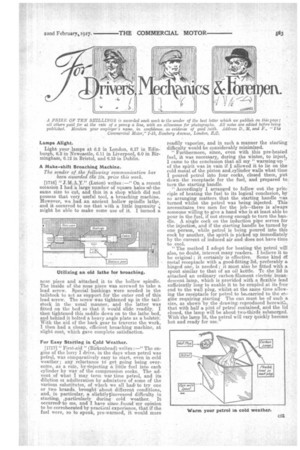• A PRIZE OF TEN SHILLINGS is awarded each week
Page 23

If you've noticed an error in this article please click here to report it so we can fix it.
to the sender of the best letter which we publish on this page; all others paid for at the rate of a penny a line, with an allowance for photographs, All notes are edited before being publidied. Mention your employer's name, in confidence, as evidence of good faith. Address D., M, and F., "Ms Commercial Motor," 7-1,5, Rosebery AVE4148, London,
Lamps Alight.
Light your lamps at 6.2 in London, 6.37 in Edinburgh' 6.3 in Newcastle, 6.11 in Liverpool? 6.0 in Birmingham, 6.12 in Bristol, and 6.53 in Dublin.
A Make-shift Broaching Machine.
The sender of the following communication has been awarded die 10s. prize this week.
[1716] " j.M.A.Y." (Luton) writes :—" On a recent occasion I had a large number of square holes nfl the same size to cut, and this in a shop which did not possess that very useful tool, a broaching machine. However, we had an ancient hollow spindle lathe. and it occurred to me that with a little ingenuity might be able to make some use of it. I turned a nose piece and attached it to the hollow spindle. The inside of the nose piece was screwed to take a lead screw. Special bushings were needed in the tailstoek to act as support for the outer end of this lead screw. The screw was tightened up in the tailstock in the usual manner, and the latter was fitted on the bed so that it would slide readily. I then tightened this saddle down on to the lathe bed, and behind it bolted a heavy angle plate as a bolster. With the aid of the back gear to traverse the work, I then had a cheap, efficient broaching machine, at slight cost, which gave complete satisfaction.
For Easy Starting in Cold Weather.
L17171 ''First-aid " (Birkenhead) writes :—" The engine of the lorry I drive, in the days when petrol was peirol, was comparatively easy to start, even in cold weather; any reluctance to get going being evercome, as a rule, by dinjecting a little fuel into each cylinder by way of the compression cocks. The advent of what I may term wai time petrol, and its dilution oi adulteration by admixture of some of the various substitutes, of which we all had, to try one or two brands. brought 'about different conditions, and, in particular, a slightlyfincreased difficulty in starting, ,particularly during cold weather.. It occurred, to me, and I have sinoe.forind-my opinion to be corroborated by practical experience, that if the fuel were, so to speak, pre-warmed, it would more
readily vaporize, and in such a manner the starting difficulty would be considerably minimized.
"Furthermore, since' even with this pre-heated fuel, it was necessary, during the winter, to inject, I came to the conclusion that all my " warming-up " of the spirit was in vain if I allowed it to lie on the cold metal of the piston and,.cylinder walls what time I poured petrol into four cocks, closed them, put down the receptacle for the fuel, and prepared to turn the starting handle. " Accordingly I arranged to follow out the principle of heating the fuel to its logical conclusion, by so arranging matters that the starting handle 778S turned whilst the petrol was being injected. This necessitates two men for the job—there is always someone willing, to give a hand who is at least able to pour in the fuel, if not strong enough to turn the handle. A single cock on the induction pipe serves for the injection, and if the starting handle be turned by one person, while petrol is being poured into this cock byanother, the spirit is picked up immediately by the current of induced air and does not have time to cool.
"The method I adopt for heating the petrol will also, no doubt, interest many readers. I believe it to be original ; it certainly is effective. Some kind 61 metal receptacle with a good-fitting lid, preferably a hinged one, is needed ; it must also be fitted with a spout similar to that of an oil kettle. To the lid is attached an ordinary carbon-filament electric incandescent lamp, which is provided with a flexible lead sufficiently long to enable it to he coupled.at its free end to the wall plug, whilst at the same time allowing the receptacle for petrol to lee:carried to the eegifie requiring starting The can must be of such a size, as shown by the drawing reproduced herewith, that with half a pint of petrol contained, and the lid closed, the lamp will be about two-thirds submerged. Witbthe lamp lit, the petrol will very quickly become hot and ready for use.
























